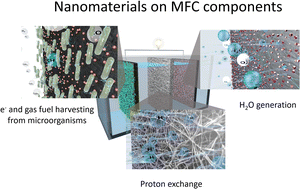Nanocomposite use in MFCs: a state of the art review
Abstract
Microbial fuel cells (MFCs) have been gaining attention as a promising technology for sustainable energy production through the metabolic processes of microorganisms. The materials traditionally employed in this field have fallen short in facilitating efficient microbial-electron transfer and subsequent current generation, posing significant challenges for practical applications. To overcome this hurdle, the integration of nanomaterials into MFC components has emerged as a promising avenue, capitalizing on their unique physical and chemical properties to drive iterative advancements. In this review article, we explore the importance of nanomaterials in MFCs, highlighting their exceptional attributes such as high surface area-to-volume ratio, stability, durability, and selectivity. These advancements could hold the key to accelerating the recognition of MFCs as a powerful platform technology.



 Please wait while we load your content...
Please wait while we load your content...